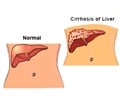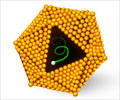In patients with compensated (early stage) hepatitis C virus-related cirrhosis, antiviral combined therapy offers an interesting rate of response, ending in viral clearance.
The diffusion of hepatitis C virus infection worldwide is astonishing. Liver cirrhosis is present in at least 10-20% of these infected patients, with highly increasing health care and emotional costs.
Unfortunately post-therapy data on different aspects of the illness, such as the residual liver function, measured as Total Overnight Salivary Caffeine Assessment (TOSCA, a liver test of microsomal function), and hepatic hemodynamics to indirectly evaluate the portal hypertension, measured as the Resistive Index of Splenic Artery (SARI) at Ultra Sound Doppler are still lacking, because to date only the survival rate and hepato-carcinoma appearance have been studied in depth.Thirty five cirrhotic patients (24 grade A5 and 11 grade A6 of the Child-Pugh classification system, used to assess illness severity), with active virus replication and treated for a mean period of three years with moderate doses of Interferon-alpha and Ribavirin were compared to a cohort of 36 patients with similar characteristics and without antiviral treatment. TOSCA was determined at the starting point and three times throughout the course of therapy after a mean period of one year. Meanwhile, the SARI was only measured at the beginning and end of the study.
The more notable findings are as follows. Thirteen treated patients showed a significant TOSCA improvement. A reduction greater than 20% on the Resistive Index of Splenic Artery was obtained in eight of the patients with improved liver function. This previously abnormal Doppler parameter showed a clear total decreasing tendency at the end of therapy. Hepatitis C virus clearance was achieved in four patients at a median period of eight months of combined therapy. In the cohort of non-treated cirrhotic patients, not only the considered parameters remained unchanged, but three patients ended with a worse Child-Pugh score.
Dr. Tarantino and his team from the Federico II University Medical School believes that moderate-dosed, prolonged antiviral therapy can make stable or ameliorate residual liver function, the entity of portal hypertension and the compensation status, all at acceptable costs. In this way, more severe liver cirrhosis complications, such as variceal hemorrhage, the appearance of refractory ascites and advanced encephalopathy, are can be delayed, thereby prolonging the survival period of many patients. His team, however, still emphasises the need to evaluate individuals affected by liver cirrhosis using alternative, non-invasive, and easily repeatable parameters of outcome to better understand the progression of this illness.
Source-Eurekalert
SPH /J











